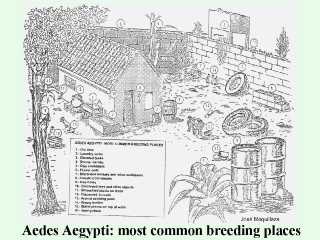 Click for larger
picture |
Tin
cans, bottles, vases, buckets, milk cans, roof gutters, animal drinking bowls and unused
toilets fairly represent containers attractive for oviposition. Tree holes, rock holes and
wells are other sites. One crucial site is the standard 200-liter drum containing water
for households without piped water, and these drums are often treated with a larvicide.
See the sketch by Jose Moquillaza. Although common, bottles are not important like tires,
because female mosquitoes do not prefer them. Containers can be observed directly or with
ovitraps used for appropriate estimates of container preference and the size of the
mosquito population. Of course, mosquito populations
respond directly to rain. |
